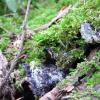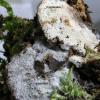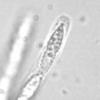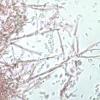
01-09-2015 23:29
 Tanja Böhning
Tanja Böhning
Hallo, Hier j´ai trouvé un Hypomyces dans ma lo

02-09-2015 16:49
Eduard OsieckDoes anybody have an idea about the identity of th

05-09-2015 15:14
Very little example.. only one sample ? found. (26

04-09-2015 23:12
Buena tarde, ando buscando este artículo pero no

03-09-2015 00:16
 Marcel Heyligen
Marcel Heyligen
Hallo everybodyDoes anyone have following document

02-09-2015 10:53
 Jakob Schneller
Jakob Schneller
Dear collegues can you please help me identifying
 Hallo,
Hallo,Hier j´ai trouvé un Hypomyces dans ma loupe sur l´hymenium d´un polypore indéterminé avec un croûte fort (Heterobasidion peut-être). Macroscopique je croyais d´avoir un Cortiniaceae.
Les péritheces oranges/jaunes sont sous le subiculum et seulement les papilles font des petits points là où le Hypomyces est "mûr". Macroscopique il paraît un peu rosatre à ces places.
L´anamorphe se disdingue par la couleur plus blanc.
Le péritece mesure (écrasé dans le microscope) 300 mü. Les spores sont fusoides avec ornamentations bien visibles. Elles ont des granules jaunâtres et 1 septum environ au milieu.
La longuer est très differente, il commence à 12x3,5 et la spore la plus longue a eu 22x3. La plupart a eu 13-15 x 3-4.
Les conidias sont cylindriques ou ovales avec 1 septum (et plus ou moins ficelés) ou sans septum. 6-9 x 3-4
Avec le clé (qui est relié sur cette site), j´arrive à Hypomyces polyporinus.
Viele Grüße,
Tanja

je ne pense pas que ta récolte corresponde à H. polyporinus qui est spécifique de Trametes versicolor et qui macroscopiquement ne ressemble pas à ton illustration.
Je te suggère de charger l'article de Poldmaa & Samuels 1999, Mycologia 91: 177-199, Aphyllophorous species of Hypomyces with KOH negative perithecia, disponible sue Cyberliber.
En combinant tes observations sur le teleomorphe et l'anamorphe tu trouveras peut être une réponse.
Bonne chance,
Jacques





